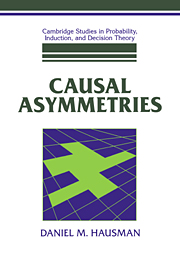Book contents
- Frontmatter
- Contents
- List of Figures
- Acknowledgments
- Introduction: Causation and its Asymmetries
- 1 Metaphysical Pictures and Wishes
- 1* Transfer Theories
- 2 Is Causation a Relation Among Events?
- 3 Causation, Regularities, and Time: Hume's Theory
- 4 Causation and Independence
- 4* Causation, Independence, and Causal Connection
- 5 Agency Theory
- 5* Causal Generalizations and Agency
- 6 The Counterfactual Theory
- 6* Independence and Counterfactual Dependence
- 7 Counterfactuals, Agency, and Independence
- 7* Agency, Counterfactuals, and Independence
- 8 Causation, Explanation, and Laws
- 8* Causation, Explanation, and Independent Alterability
- 9 Probabilistic Causation
- 10 Causation and Conditional Probabilities
- 10* Causal Graphs and Conditional Probabilistic Dependencies
- 11 Intervention, Robustness, and Probabilistic Dependence
- 11* Interventions and Conditional Probabilities
- 12 Operationalizing and Revising the Independence Theory
- 12* Probability Distributions and Causation
- 13 Complications and Conclusions
- Appendix A Alphabetical List of Propositions
- Appendix B List of Theorems
- References
- Index
2 - Is Causation a Relation Among Events?
Published online by Cambridge University Press: 20 April 2010
- Frontmatter
- Contents
- List of Figures
- Acknowledgments
- Introduction: Causation and its Asymmetries
- 1 Metaphysical Pictures and Wishes
- 1* Transfer Theories
- 2 Is Causation a Relation Among Events?
- 3 Causation, Regularities, and Time: Hume's Theory
- 4 Causation and Independence
- 4* Causation, Independence, and Causal Connection
- 5 Agency Theory
- 5* Causal Generalizations and Agency
- 6 The Counterfactual Theory
- 6* Independence and Counterfactual Dependence
- 7 Counterfactuals, Agency, and Independence
- 7* Agency, Counterfactuals, and Independence
- 8 Causation, Explanation, and Laws
- 8* Causation, Explanation, and Independent Alterability
- 9 Probabilistic Causation
- 10 Causation and Conditional Probabilities
- 10* Causal Graphs and Conditional Probabilistic Dependencies
- 11 Intervention, Robustness, and Probabilistic Dependence
- 11* Interventions and Conditional Probabilities
- 12 Operationalizing and Revising the Independence Theory
- 12* Probability Distributions and Causation
- 13 Complications and Conclusions
- Appendix A Alphabetical List of Propositions
- Appendix B List of Theorems
- References
- Index
Summary
In my initial picture, events are located in space and stretch through time. Causation links them. Our ability to infer that some events have occurred or will occur – when we know that other events occurred – rests on objective causal relations among events. This chapter will articulate and modify this picture. I shall argue that causation relates events in virtue of explanatory links between simple tropes. Tropes are located values of relevant variables or located instantiations of relevant properties. Claims about causal relations among events are true in virtue of the relations that obtain among simple tropes, and so it turns out that the theory of causation is largely independent of questions about the metaphysics of events and facts.
Some philosophers take tropes to be properties that are also particulars and specifically distinguish tropes from property exemplifications (Ehring 1997), and some take tropes to be fundamental and attempt to replace an ontology of substances and properties with an ontology of tropes (Williams 1953). My use of tropes is less metaphysically ambitious. I regard a trope – intuitively something like the whiteness of a particular pebble at a particular time – as a located instantiation of a property. I do not regard tropes as particularized properties, and I do not think they are ontologically fundamental, but I also think that this chapter's claims about the relata of the causal relation are independent of these questions concerning the status of tropes. The reason why I speak of “simple tropes” is that events can be conceived of as instantiations of exceedingly complicated properties and thus as themselves tropes.
- Type
- Chapter
- Information
- Causal Asymmetries , pp. 18 - 35Publisher: Cambridge University PressPrint publication year: 1998



